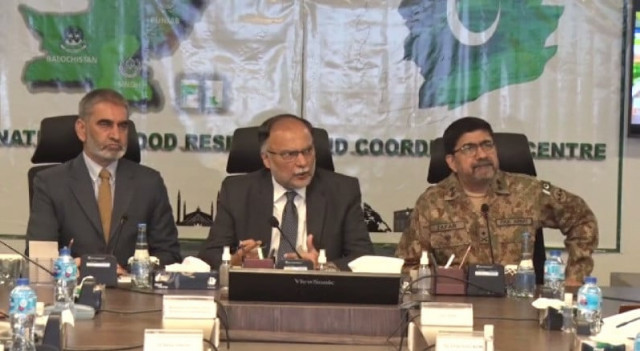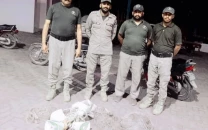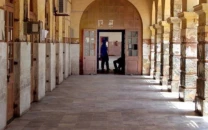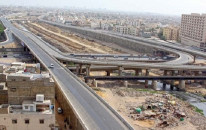NFRCC takes stock of latest flood situation, UNSG to visit centre
UNSG Guterres to visit flood-affected areas in the country

United Nations Secretary-General António Guterres is scheduled to visit the National Flood Response Coordination Centre (NFRCC) on Friday and will receive a briefing on the scale of damage.
During the morning session of the flood response centre today, a comprehensive review of the current flood situation and response measures with a focus on the rehabilitation plan was taken.
Guterres arrived in Pakistan on Friday for a two-day solidarity visit amidst the catastrophic situation caused by floods in the country. He was received by Minister of State for Foreign Affairs Hina Rabbani Khar at the Islamabad International Airport.
During his visit, Guterres will be visiting flood-affected areas in the country.
Read: High flood forecast for Kotri Barrage
The districts that are affected the most in Sindh due to the heavy rains and flooding are, Qambar Shahdad Kot, Jacobabad, Larkana, Khairpur, Dadu, Noshero Feroz, Thatta and Badin, while Quetta, Naseerabad, Jafarabad, Jhalmagsi, Bolan, Sohbatpur and Lasbela are worst-hit in Balochistan.
Meanwhile, the most impacted by floods in K-P are Dir, Swat, Charsadda, Kohistan, Tank and DI Khan, whereas, in Punjab, Dera Ghazi Khan and Rajanpur districts are severely affected by the catastrophe.
Roads, railway restoration underway
After land sliding at a 24-kilometre section of Wangu Hills, restoration work is underway, with a two-kilometre area cleared already, said the statement from the NFRCC.
Meanwhile, the N-50 in Dera Ismail Khan is open for traffic, and work on the approach road and the launch of a bailey bridge is currently underway.
The road from Meher Johi Canal to Khairpur Nathan Shah has also been closed due to being inundated and will reopen after the drainage of water.
Read: Another cut made to save Sehwan, Bhan Saeed from flood water
The flood response centre added that for railways connectivity, the bridge connecting Quetta to Taftan has been damaged and a 27-kilometre track is currently being restored between Quetta and Noushki.
The railway bridge connecting Quetta to Sibbi has also been damaged near Mach and the restoration work is underway.
In Sindh, the inundation over the track from Rohri, Dadu to Habibkot has caused a suspension of traffic, which will resume after the water has been cleared in the area.
The track between Rohri to Nawabshah has also been submerged and resumption of traffic will depend on water clearance.
Army relief efforts underway
As many as 446 Army Aviation helicopter sorties have been used thus far for the evacuation of stranded people in various parts of the country.
In the past 24 hours, 32 sorties have been flown and 163 stranded individuals have been rescued, while 34 tons of relief items have been delivered to the flood victims, said the NFRCC.
Read: Army relief fund ‘receives Rs417m’ so far
The total number of stranded individuals who have been evacuated till now has reached 4,264.
On the other hand, 147 relief camps and 284 relief collection points have been established in Sindh, South Punjab and Balochistan for families affected by the catastrophe.
6,031 tons of food items collected in donations
As much as 6,031.5 tons of food items, 1,032.1 tons of substance items and 3,178,092 medicinal items have been collected thus far in donations. Out of this, 5591.3 tons of food, 991.8 tons of substance and 2,969,942 medicinal items have been distributed till now.
Read: US to operate massive humanitarian air bridge for flood victims
25 medical camps established
More than 250 medical camps have been established in which more than 0.1 million patients have been treated all across the country and provided with 3-5 days of free medicine.
Pakistan Navy escalates relief efforts
Pakistan Navy has established four flood relief centres, six central collections points, two tent cities accommodating 4,189 people and 50 medical camps in which 33,973 patients have been treated countrywide.
Moreover, around 1,200 tons of ration, 2,780 tents and 460,577 litres of mineral and freshwater have also been distributed in various districts.
Read: Flood losses estimated up to $20 billion
Apart from that, Pakistan Navy’s 23 Emergency Response Teams (ERTs) equipped with 45 motorized boats and two hovercrafts have been deployed in 10 districts and have rescued 13,063 stranded personnel.
The maritime force has also deployed two helicopters in Sindh. Till now, 47 sorties have been flown, rescuing 465 stranded people and distributing 3,297 packets of ration and 300 kgs of medicine.
Eight diving teams of the Pak Navy have also carried out 26 diving operations in affected areas across Pakistan.
PAF nationwide relief and rescue operations continue
Pakistan Air Force has also conducted 87 C-130, 92 MI-17, and 54 AW-139 air sorties, rescued 1,521 personnel, distributed 2,577 tents, 165,357 food packets, 2482.24 tons of ration and established 19 tent cities accommodating 16,695 people, 50 relief camps and 41 medical camps in which 37,789 patients have been treated across the country so far.
Read: Mass migration of flood affectees towards Sehwan, Jamshoro begins
PAF is fully committed in Sindh’s Nawabshah, Sukkur, Mirpur Khas, Talhaar, Jacobabad, Sehwan and Perpatho.
It is also conducting relief operations in Baclochistan’s cities of Bamungli, Killa Abdullah and Killa Saifullah, as well as Rajanpur and DG Khan in Punjab and Gilgit Skardu, Ghizer, Naltar, Ganche in G-B.
Nowshera, Charsadda, Kheshgi, Saidu Sharif, Shangla, Laram have also remained under focus in K-P.



















COMMENTS
Comments are moderated and generally will be posted if they are on-topic and not abusive.
For more information, please see our Comments FAQ